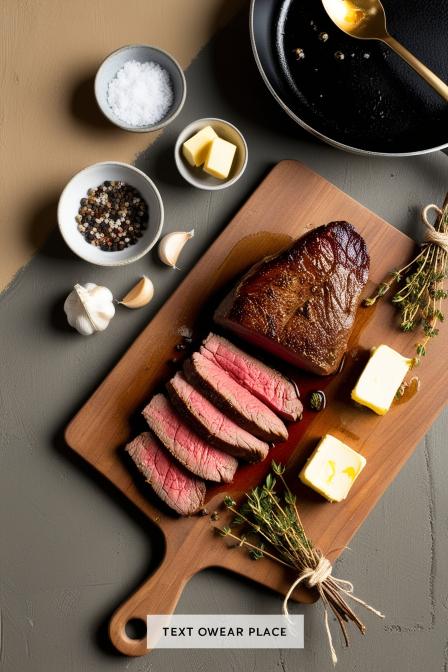Ever had a steak that made you stop mid-chew and go, “Wait… what the heck is this magic?” That was me, years ago, sitting in a tiny French bistro off Rue Saint-Honoré. I’d forked into what looked like a perfectly normal piece of beef—and 15 seconds later, I was questioning every dry, chewy steak I’d eaten before. That, my friend, was filet mignon. But here’s the kicker: it doesn’t need a Michelin-star kitchen or a sous vide wand to do it justice. You can make it quick. You can make it easy. And it can still taste like it walked outta a five-star dining room.
This ain’t your slow-roasted, crust-rubbed, smoked-for-hours kinda dish. This filet mignon is seared hot, finished fast, and designed for those moments when you want something stupidly fancy without the stupidly long prep.
What Is Filet Mignon & Why It’s Worth the Hype
Filet mignon is the crown jewel of steaks. Cut from the tenderloin—the least worked muscle in the cow—it’s almost freakishly tender. Like butter that took a solid form. No bones. Barely any fat marbling. Just pure, lean beef that melts in your mouth like velvet. It’s mild, sure, but that just makes it the perfect blank canvas for flavor bombs like garlic, thyme, wine reductions, peppery crusts, you name it.
But lemme tell ya—if you overcook it, you ruin it. The margin for error? Tiny. But if you get it just right? You’ve got yourself a 20-minute masterpiece that feels like you dropped \$60 on dinner. Let’s get into it.
Ingredients & Substitutions
Every steak’s secret weapon is quality, plain and simple. You can’t cheap out on a filet mignon and expect miracles. But that doesn’t mean you need gold-plated ribeyes either. Know what to buy, and you’ll be golden.
Here’s what you’ll need, and how to work around things if you don’t have exactly what’s called for:
| Ingredient | Purpose | Substitution / Note |
|---|---|---|
| Filet mignon (6-8 oz) | Star of the show | Beef tenderloin medallions work too—just trim well |
| Kosher salt | Dry brining & flavor | Sea salt okay, just not iodized table salt please |
| Fresh cracked pepper | Adds sharp bite, crusty texture | Pre-ground is a sin here. Don’t do it. |
| Neutral oil (avocado, grapeseed) | High-heat searing | Don’t use olive oil—it’ll smoke and taste bitter |
| Unsalted butter | For basting | Salted is fine if you skip extra salt elsewhere |
| Garlic cloves (smashed) | Aromatic base | Garlic powder? Only in a pinch, but fresh is miles better |
| Fresh thyme or rosemary | Herbal depth | Dried herbs? Nah—fresh only for basting |
| Optional: shallots | Sweet, caramelized depth | Red onions if desperate, but shallots are better |
Why fresh herbs and garlic? When you’re basting a hot steak in butter, you’re not just lubing it up. That butter carries those fresh aromatics straight into the meat. Dried herbs burn. Garlic powder toasts and gets bitter. You want that fresh, herby sizzle.
Step-by-Step Instructions
Timing is everything. You don’t wanna multitask with this one. You babysit it. You admire it. You treat it like royalty. And it’ll reward you.
Step 1: Let the steak come to room temp
Pull your filet outta the fridge at least 30 mins before cooking. Cold steak straight into a hot pan equals uneven cooking. You’ll get a gray ring inside instead of that dreamy pink center.
Expert tip: Dry the steak with paper towels. Moisture is the enemy of a good sear.
Step 2: Season like you mean it
Sprinkle kosher salt and plenty of freshly cracked black pepper on all sides. Don’t be shy. The crust needs it. Let it sit out uncovered—this acts like a mini dry brine.
Step 3: Sear hot and fast
Get a heavy skillet (cast iron preferred) screaming hot. Add a splash of neutral oil. When the oil shimmers, add the steak. It should roar like a jet engine. That’s your Maillard reaction doing its thing—caramelizing, browning, building flavor.
Common mistake: Flipping too early. Don’t mess with it. Give it 2–3 minutes per side for a solid sear.
Step 4: Add butter + aromatics
Once both sides are crusty, drop in your butter, smashed garlic, and herbs. Tilt the pan and baste the steak repeatedly with a spoonful of that sizzling, aromatic butter.
Smells ridiculous, right? Like a steakhouse snuck into your kitchen.
Step 5: Finish in the pan or oven
For thicker cuts (2 inches+), pop it into a preheated oven (400°F) for 3–5 minutes after searing. Use a meat thermometer:
- Rare: 120–125°F
- Medium-rare: 130–135°F
- Medium: 135–140°F
Never go past medium for filet. Please. Don’t do that to your steak.
Step 6: Rest it, always
Tent loosely with foil and let it rest for 5–10 mins. This lets the juices settle back into the meat instead of spilling out the second you slice it.
Variation: Wanna go smoky? Add a dash of smoked paprika to your seasoning mix. Want some tang? Finish with a splash of lemon juice or balsamic during basting.
Cooking Techniques & Science
Here’s why this method works like magic:
Searing locks in flavor—not juices
Searing doesn’t “seal” in moisture (that’s a myth), but it does create that golden-brown crust packed with umami-rich compounds (hello, Maillard reaction). It’s flavor alchemy.
Butter basting infuses fat-soluble flavors
Garlic, herbs, and shallots release their oils into the butter, which then coats the steak. It’s flavor delivery on steroids.
Why cast iron?
It holds heat evenly and intensely. Perfect for that hard, even crust. Stainless can work, but non-stick? Nah, skip it. It’ll cry under high heat.
Tools that make it better:
- Cast iron skillet
- Instant-read thermometer
- Fish spatula or tongs (never stab it with a fork!)
- Small spoon for basting
How to store & reheat
Fridge: Wrap tightly in foil or airtight container. Use within 3 days.
Reheat: Avoid microwave. Instead, warm in a low oven (275°F) for 10–15 minutes, covered in foil, until warmed through. Optional: quick sear in butter to refresh the crust.
Filet Variations
- Herb crusted: Press minced rosemary + thyme into the steak before searing.
- Peppercorn crusted: Coat in crushed green/black pepper, serve with brandy cream sauce.
- Wrapped in bacon: Adds fat and flavor, helps protect against overcooking.
Serving & Pairing Suggestions
Filet mignon don’t need frills, but man—it shines with the right company.
Side Dishes
- Garlic mashed potatoes (classic and rich)
- Charred broccolini with lemon zest
- Creamed spinach (because you deserve it)
- Crispy potato stacks or hasselbacks
Sauces that sing
- Red wine reduction
- Shallot-butter pan sauce
- Béarnaise (fancy, but doable)
- Chimichurri (for a bold, fresh contrast)
Drinks to match
- Red wine: Cabernet Sauvignon, Bordeaux, Malbec
- Cocktail: Old Fashioned or dry Manhattan
- Non-alcoholic: Sparkling water with lemon + rosemary
Plating ideas
Slice it against the grain (yes, even tenderloin has a slight grain), fan it out on a warm plate, spoon sauce in a zigzag, add a microgreen sprinkle, and you’ve just gone from home cook to Top Chef plating.
Best Time to Serve Filet Mignon
This ain’t your meal-prep Monday protein. This is anniversary dinner, date-night-in, “I just closed a deal” or “it’s Friday and I’m still breathing” food. Serve it fresh—hot from the pan, butter still bubbling, crust still snapping.
Avoid reheating if possible. It’s magic in the moment.
Final Thoughts: Why This Filet Recipe Works Every Time
Filet mignon can be intimidating. It’s expensive, tender, and somehow carries this air of luxury that makes folks nervous to cook it. But when you simplify the steps and respect the ingredients, it becomes one of the easiest fancy meals you’ll ever make.
High heat + short cook time + a lil’ butter love = a foolproof, mind-blowingly tender steak.
Don’t overthink it. Just watch it. Smell it. Listen to it sizzle. You’ll know when it’s right.
Final expert tips:
- Rest your steak—it’s not optional.
- Always season aggressively—filet needs it.
- Thermometers are your best friend—guesswork kills steak.
- Don’t crowd the pan—ever. Let it breathe.
FAQs
1. Can I use filet mignon in the air fryer?
Technically yes, but it won’t get the same deep crust or aromatic butter baste. Use a pan for best results.
2. How do I know if filet mignon is overcooked?
It’ll feel firm and dry. Use a thermometer—don’t eyeball it. Pull it early; residual heat will finish it.
3. Can I freeze cooked filet mignon?
Yep, but it’ll lose some tenderness when thawed. Better to freeze it raw if possible.
4. What’s the difference between filet mignon and tenderloin?
Filet mignon is a specific cut from the tenderloin—usually the thickest, most tender end.
5. Why is filet mignon so expensive?
It’s tiny. Only about 4-6 lbs of tenderloin per cow. Supply’s low, demand’s high. Simple steak economics.
Now go forth. Sear boldly. Rest religiously. Eat gloriously.

